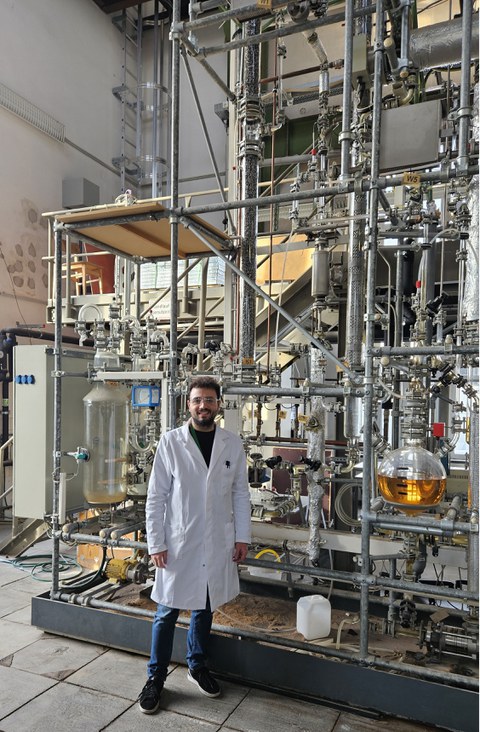Feb 10, 2025
Cooperation between EVT and CVT: synergies for a sustainable future

Domenico Ricchiari from the research group at the University of Naples in front of the CO2 capture plant at TU Dresden, where he is doing research for a semester during his doctoral studies.
The challenges of climate change and the energy transition require innovative approaches and interdisciplinary cooperation. At TUD Dresden University of Technology, the Chair of Energy Process Engineering (EVT) and the Chair of Chemical Process Engineering (CVT) work hand in hand to research and further develop new technologies for CO₂ capture and utilization. This cooperation combines expertise from various areas of process engineering and lays the foundation for sustainable solutions in the field of energy technology and the chemical industry.
A rediscovery with great potential
The collaboration between the Chair of Energy Process Engineering (EVT) and the Chair of Chemical Process Engineering (CVT) began with a common goal: to reactivate and use an existing CO₂ separation plant at the Institute.
The plant was originally built and used for research purposes, but has not been used as frequently in recent years. However, in view of the growing importance of carbon capture technologies for reducing CO₂ emissions, this plant is a key to future research work and offers potential for conducting sustainable energy and environmental research together.
A common goal: understanding CO₂ as a resource
CO₂ capture technologies are becoming increasingly important worldwide, as they can make a decisive contribution to overcoming the challenges of climate change and the energy transition.
The CO₂ capture plant is characterized by its size and complexity - a unique selling point, as comparable plants at universities in Germany are rare. It therefore offers enormous potential for researching practical and innovative solutions.
The current focus is on an experimental campaign in which the efficiency of a new type of amine solution is being tested. This solution combines two amines in order to utilize the advantages of both substances. The aim is to optimize absorption and regeneration performance. Initial simulations have shown promising results, which are now to be validated in experiments.
International expertise strengthens the research location
An important aspect of the collaboration is the exchange with international research groups. Domenico Ricchiari, a visiting researcher from the renowned Laboratory for the Intensification of Separation Processes for the Environment and the Circular Economy at the University of Naples, is supporting the current research at the Dresden facility this semester as part of his doctoral studies. At his home university, he was already intensively involved in gas purification and separation, particularly for SO₂, NOₓ and CO₂. Other members of the Neapolitan research group are Prof. Francesco Di Natale, Prof. Alessandro Erto and Prof. Domenico Flagiello. Thanks to the collaboration, the lively exchange between the two institutions - TU Dresden and the Università degli Studi di Napoli Federico II - will be further strengthened.
How does the CO₂ separationplantwork?
CO₂ is a common by-product of chemical and thermal processes. While CO₂ can be used as a raw material in innovative processes such as the synthesis of synfuels (synthetic fuels) or methanol, the challenge is to provide it in a pure form.
The CO₂ separation plant is based on a chemical absorption process that separates CO₂ from gas streams. Two columns play the central role here: an absorption column and a regeneration column. In the absorption column, a special amine solution chemically binds the CO₂ and separates it from other gases. The CO₂ is then released for further use by adding heat in the regeneration column, while the amine solution is processed for the next cycle.
Research for the energy transition
The combination of expertise from EVT and CVT, together with innovative approaches and modern infrastructure, provides a solid foundation for developing sustainable process technologies. New research work will further exploit the potential of the CO₂ capture plant to contribute to the energy transition and climate protection.
